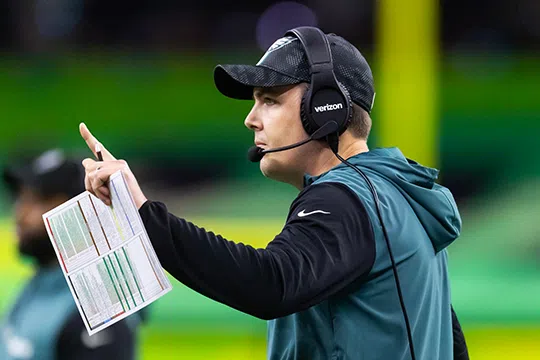By Ross Jackson
A new offensive system is on the way for the New Orleans Saints. The team underwent a slight change last year in shifting to a wide zone offense after years of running former head coach Sean Payton’s Air Coryell/West Coast blend.
Now, new head coach Kellen Moore and his offensive coaching staff will bring a new-look scheme to the city that, unlike previous systems, doesn’t really have a name.
Our recent interview with run game coordinator T.J. Paganetti, who is one of the most exciting hires from this recent coaching staff change, confirmed that the Saints will use parts of Moore’s offenses from each stop.
Moore and offensive coordinator Doug Nussmeier have previously held positions with the Dallas Cowboys, Los Angeles Chargers and last year’s Super Bowl champion Philadelphia Eagles.
“He’s brought stuff from,” Paganetti said. “Him and Doug (Nussmeier), have brought stuff from Chargers, Cowboys. He’s even got stuff from his Boise days, Philly.”
Moore is the winningest quarterback in college football history during his playing days at Boise State. Taking from that success makes a ton of sense.
With this in mind, and our recent insight into the upcoming rushing attack, here is a look at some key elements to each of Moore’s previous run game production and how it compares to last season’s Saints endeavor.
We’ll dive into last year’s Saints and Eagles teams, the 2023 Chargers season and the Cowboys of 2022, Moore’s final year with the club vs. his first in 2019.
The 2024 Saints
No. 14 in rushing yards | No. 15 in rushing touchdowns | No. 14 in yards per carry
Zone: 266 (72.5%)
Man: 101 (27.5%)
YBC/Att: 1.47
Inside: 27.9% (least in the NFL)
Outside: 69.8% (most in the NFL)
Light: 33.8%
Stacked: 26.6%
New Orleans was a heavy outside zone run team last season. That should serve as no surprise with the wide zone scheme adoption they undertook with former offensive coordinator Klint Kubiak. Zone runs require the offensive line to move laterally in order to create multiple lanes for the running back to choose from based on what path is more advantageous. The line almost moves to attack certain areas of the field rather than a specific player they are assigned to block.
Outside refers to the point of attack for the ball-carrier being outside of the tackles. The Saints did this more than any other team in the league in 2024.
One key component to any run game is yards before contact (YBC). On a per-attempt basis, New Orleans ranked No. 13 in the league in this metric. Meaning that the rushing lanes being created for backs were blocked well enough to pick up yards before being touched by a defender at a slightly above average rate. However, this number is quickly dwarfed by the Eagles of not only 2024 (2.17) but of 2023 also (2.56).
That’s important to highlight for two reasons:
- The 2024 season had Moore and running back Saquon Barkley as contributors in Philadelphia.
- The 2023 season had neither, but did have Paganetti as run game specialist.
The Eagles have also consistently had one of the league’s best offensive lines, which create the potential for yards before contact, something New Orleans is in pursuit of building as well.
The 2024 Eagles
No. 2 in rushing yards | No. 2 in rushing touchdowns | No. 5 in yards per carry
Zone: 342 (56.3%)
Man: 265 (43.6%)
YBC/Att: 2.17
Inside: 48.5%
Outside: 47%
Light: 44.9%
Stacked: 25.8%
The Eagles were much more balanced under Moore. Not too much zone, not too much man, not too much inside rushing attempts, not too much outside.
One thing they did consistently: force rushes against light boxes. Moore lives to run out of two tight end sets, but also never fears running out of 11 personnel, or three wide receiver sets.
When an offense goes into the huddle with three wideouts, defenses tend to match with their nickel defense. This sometimes keeps the box light, in terms of number of defenders (six or less) and size of defenders, as well thanks to the additional defensive back that takes the field.
This resulted in the Eagles having 40 designed runs (no quarterback scrambles) that went for more than 15 yards. New Orleans had only 15 such rushes in 2024.
The 2023 Chargers
No. 25 in rushing yards | No. 20 in rushing touchdowns | No. 27 in yards per carry
Zone: 197 (58.1%)
Man: 142 (41.9%)
YBC/Att: 0.97
Inside: 49.9%
Outside: 47.8%
Light: 53.8%
Stacked: 11.8%
The Chargers’ run game wasn’t as successful as Moore’s other stops. But there are some key takeaways here. The scheme dialed up an overwhelming amount of rushes against light boxes. Meanwhile, the balance of inside vs. outside and zone vs. man stayed to expectation.
Moore has been a diverse and multi-dimensional play caller at every stop, even if he changes the approach around a bit to match the talent on the roster. True to his calling card.
The 2022 Cowboys
No. 9 in rushing yards | No. 2 in rushing touchdowns | No. 18 in yards per carry
Zone: 259 (52.4%)
Man: 235 (47.6%)
YBC/Att: 1.02
Inside: 42.9%
Outside: 54.4%
Light: 34.1%
Stacked: 23.7%
Again balanced and with 32 designed runs of more than 15 rushing yards. The heavy runs against the light box and balance across schemes was there for practically half of his Cowboys seasons. While 2019 and 2020 were heavily weighted toward the zone run, 2021 and 2022 fell closer in comparison to one another.
This was the last season in which the outside run game overwhelmed the inside attack in one of Moore’s offenses. That happened with speedy back Tony Pollard starting to take over as the focus of the rushing game. A keen example of Moore shifting his play calling to match his personnel.
Moore also proved to be more willing to run against stacked boxes here. This is something that would go away when he arrived in Los Angeles, where he had a run of backs less capable in those situations.
The 2019 Cowboys
No. 5 in rushing yards | No. 7 in rushing touchdowns | No. 5 in yards per carry
Zone: 253 (63.6%)
Man: 145 (36.4%)
YBC/Att: 1.37
Inside: 42.3%
Outside: 55.5%
Light: 39.4%
Stacked: 18.7%
This was a very different approach overall for Moore during his first year as an NFL playcaller. He called heavy zone runs and his inside/outside distribution was weighted to outside the tackles. He was less avid about running against stacked boxes, something that would ebb and flow during his time in Dallas.
What It All Means
This shows that Moore has been successful with just about any style of run, with the exception of his time with the Chargers whose running back room left much to be desired. Moore changes his approach to fit his players and typically finds a way to win with those shifts.
Of his six years as an NFL playcaller, Moore’s rushing offenses have finished top-ten in rushing yards four times. Add to that his hand-picked coaching staff, the Saints are in store for a revival of this ground game. It may take time, but this is something that New Orleans should be looking forward to in its future.
With running back Alvin Kamara coming off of his best rushing season as a pro and a lot of young talent in the room with him, Moore shouldn’t starve for production from his roster. Devin Neal, Saints’ sixth-round pick this year, looks ready-made for the scheme and third-year back Kendre Miller should be able to get back to the inside rushing game that made him so effective in college at TCU.
Moore may not have a name for his scheme, but it’s proven that his approach is effective. One of the reasons is because of his ability to change to match the talent around him and take in the input of the coaches and players.
“And the great thing about Kellen is he has no ego,” Paganetti said. “So, he’s all about the best idea wins. If something works and it’s explained well and has a good ‘why’ behind it, he’s going to do it.“






